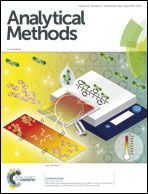Determination of pesticides in a flour substrate by chemometric methods using terahertz spectroscopy
Abstract
Terahertz time-domain spectroscopy (THz-TDS) is utilized as an effective tool for quantitative analysis of imidacloprid and carbendazim in a flour substrate. The partial least squares (PLS), principal component analysis (PCA), support vector machine (SVM) and PCA-SVM methods were used to construct linear and nonlinear regression models to correlate absorption spectra and concentrations of 21 samples based on the whole absorption spectra (0.2–1.4 THz). The multiple spectra baseline correction (MSBC) method which is based on asymmetric least squares smoothing was adopted to correct the slope baselines. The algorithm can eliminate scatter effects on the spectra and improve the signal-to-noise ratio of the THz spectra. The models were optimized by cross-validation, and their performances were evaluated with respect to root mean square error of prediction (RMSEP), correlation coefficient in the prediction set (Rp) and correlation coefficient in the calibration set (Rc). The results show that PLS delivers the best performance with the lowest errors. The optimized PLS models for both imidacloprid and carbendazim are obtained with RMSEP = 0.5439%, Rp = 0.9992 and Rc = 0.9999. Our experimental results also demonstrate that THz-TDS combined with chemometrics can be used for quantitative determination of pesticides in agricultural products.



 Please wait while we load your content...
Please wait while we load your content...